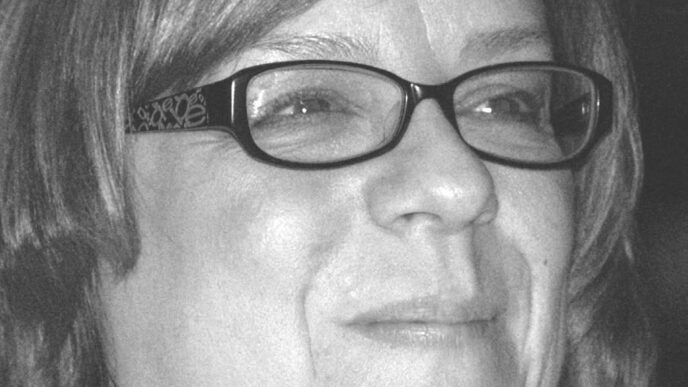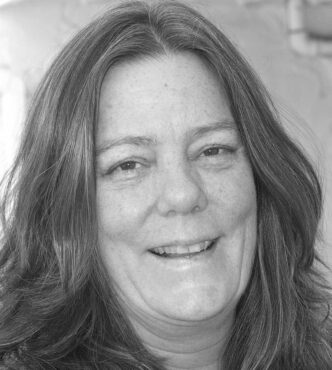Pleasant Valley Creek is the kind of a place usually found only in trout anglers’ dreams. Located just southwest of Markleeville, in Alpine County, the creek has its headwaters at the 7,359 foot elevation in the Sunset Lakes– Tamarack Lake area. It then tumbles down steep slopes before flattening out in sun-dappled Pleasant Valley, which has sweeping meadows full of wildflowers, deer, and an occasional bear, with red-tailed hawks gliding majestically in the thermals. Snow-capped Markleeville, Jeff Davis, and Raymond Peaks frame the horizon to the southwest.
For anglers, the creek is the home to rainbow, brown, and brook trout. As it flows to the east, the stream joins Hot Springs Creek and Markleeville Creek, and further on these commingled waters merge with the East Fork of the Carson River.
Pleasant Valley Creek area has another feature — one made by man. The road to the lower part of the valley has a green gate near its entrance, one put in place by the property owner.
This gate is the source of a legal dispute over blocked public access to the valley and to a trail that runs in part along Pleasant Valley Creek and that leads to Raymond, Tamarack, and Upper and Lower Sunset Lakes, Wet Meadows, the Mokelumne Wilderness Area, and other federally-owned land.
More than 900 acres in Pleasant Valley, and a substantial section of its creek, is owned by the Frederick Company, which is run by a longtime Gardnerville, Nevada, ranching family and its patriarch, Fred Dressler. The public is not currently allowed to walk the Dressler’s land without permission. Removing this prohibition is the objective of an organization known as the Friends of Hope Valley (FOHV), originally formed 25 years ago when a handful of environmentally minded Alpine County residents met to discuss how to fight plans by the Sacramento Municipal Utility District to run a power line down the middle of nearby Hope Valley — a fight that they won.
Since its formation, the FOHV has gained protective Wild and Scenic River status for the East Fork of the Carson River, organized teams of volunteers to complete restoration projects along the forks of the Carson and other streams, lobbied for plans and enforcement methods to prevent damage to rivers and meadows by off highway vehicles, placed gates and fence posts to block off-highway vehicles from damaging streams and other sensitive areas, advocated for a trail system for nonmotorized vehicles, including a trail running from Grover Hot Springs to Markleeville, opposed proposals to build a gravel pit in Hope Valley and to develop an area near the Markleeville Airport, blocked with boulders illegal camping areas, and conducted river-monitoring activities. The FOHV has also been active in securing public access to land in Alpine County.
The Legal Issue
The FOHV has filed suit in the U.S. District Court in Sacramento against the Dressler family, arguing that the public has a legal right to unfettered access based on historical use patterns. The case will be heard in January, 2011.
The legal flap is the talk of Alpine County, which has a population of only 1,145 residents. It is dominated by national forests and cattle and sheep ranches, many owned by pioneering families. Differences are typically settled by talks over fences and in local coffee shops. Unlike city folk, the locals rarely wind up in court. “We met with the Dresslers a number of times to discuss access,” said Debbie Waldear of Markleeville, the president of the FOHV, “but got nowhere, so we went to court.”
The conservation group has hired the well-known environmentally oriented law firm of Shute, Mihaly, and Weinberger to argue the case, and will have additional representation by Kerr & Wagstaffe, another San Francisco firm. Also filing briefs in the case may be attorneys for government agencies, national environmental groups, and advocates for private-property rights, such as the Sacramento-based Pacific Legal Foundation.
Why all the legal fuss over one or more trails in a remote Sierra Nevada canyon? It has attracted the high-powered lawyers because the lawsuit could open the picturesque valley to public use and also let the public cross privately owned land to gain additional access to federally-managed lands beyond the valley. The Dresslers closed access to the valley and their section of Pleasant Valley Creek in 1999 by putting a gate across the only road that leads to a trail to the highcountry. The legal issue being litigated is whether there had been “continued public use” of this and other trails in the valley before 1972. If the public had continually used trails on the property prior to 1972, then they may still have a right to keep using those trails.
The FOHV claims in the suit that “these trails have been used extensively by the public for more than 100 years to access the Alpine County high country.” There is “a long history of continuous public use of these trails, created by implied-dedication nonexclusive public easements in the trails where they cross Defendant’s [Dressler’s] land.” In addition, “Ample evidence demonstrates the trail’s lengthy history of public use,” says the suit. “A variety of maps from the 19th and 20th centuries, including a map drawn by a state judge in 1864, show the trails running through Pleasant Valley. In 1963, Sunset Magazine described the trails as providing public access to high altitude lakes.” The FOHV has been seeking anglers and hikers who may have used the area before 1972 to serve as witnesses in the upcoming trial.
The Fly-Fishing Angle
Attorneys for the Dresslers are expected to argue that access to the private property has been restricted for years and that evidence doesn’t show continued public use. South Lake Tahoe’s Jim Crouse, a fly-fishing guide who works under the name of Alpine Fly Fishing, says he has seen a map and mining claim dating back to 1864 that does not contain a trail through Pleasant Valley to the high country.
Besides, he said, there has never been a formal Forest Service trail or road in the valley. Rather, there’s a path created by ranchers driving cows from Markleeville through Pleasant Valley and up to the higher lakes to reach grazing lands. “It is not a Forest Service–maintained trail. It was created as a cow trail. The trail is often brushed over and sometimes doesn’t look like a trail,” he said, adding that it’s not one the public has used very often.
Crouse said Forest Service data shows that from 1999 to 2000, only four people signed in at a registration station at the beginning of the trail, just above the Pleasant Valley floor, that tallies the number of hikers going to the Mokelumne Wilderness. He said that he has not seen unrestricted public access to the valley since he started fishing there in 1969. “These people are trying to rewrite history,” he said. “The land is private property, a working cattle ranch.”
For the Dressler family, issues of concern over public use include damage to the property, trash, and liability. Crouse said that people have dumped garbage and motor oil in the valley, shot guns, started illegal campfires, and even sold drugs. In addition to running a fly-fishing guide business, Crouse manages the Pleasant Valley Fly Fishing Preserve, which allows anglers to fish the stream on the Dressler’s property for a fee. He said the gate was installed to keep his fly-fishing customers from driving to more remote areas along the creek, which has a history of damage from bank erosion.
“You can walk around either side of the gate,” he said, adding that signs recommend phoning to get permission to access the valley. “Some people have called to get permission to hike the high country, and we almost always give them permission to pass through,” he said, noting that the Dresslers are concerned about liability resulting from an injury. “What if someone gets bit by a rattlesnake or injured by a bull?” he asked. “The landowner might be liable if that happened.”
Crouse, who has been guiding in the area since 1984, believes that opening the trail to the public will jeopardize the good angling now found in Pleasant Valley Creek by allowing scofflaws to more easily poach the stream and damage the land and riparian habitat. “Before the closure, the public hadn’t shown any respect for the property and the fishery,” he noted. “Both were abused.”
To support the Pleasant Valley sport fishery, Crouse stocks the creek with $5,000 worth of trout each year. “I have probably spent $50,000 to buy trout since I have been working there,” he said, observing that his planted trout, which don’t stay in on place, have benefited downstream waters as far away as the East Fork of the Carson and are a boon to the local economy. He limits access to five anglers per day to protect the creek’s environment and provide a high-quality angling experience. “Ninety-five percent of Alpine County is federally owned,” Crouse noted. “There are trails everywhere. They don’t need this one.”
Within several months, attorneys for the FOHV and the Dresslers will make their arguments in court. If the judge rules in favor of the FOHV, the public will gain the ability to hike in Pleasant Valley, but the decision could lead to the loss of a private fly-fishing preserve and elimination of the business it provides to local fly-fishing guides and retailers. If the judge rules for the Dressler family, their land will remain off limits to the public, aside from those who receive permission to hike it and fly fishers willing to pay to fish there. Eastern routes of access to trout waters on public land beyond the Dressler’s property would likewise remain limited, although it’s not yet clear if this limitation is of significant concern to users of the backcountry, given the valley’s headwaters can be reached by hikers using the Pacific Crest Trail and other public routes.
Fishing and Friends
If you’re interested in learning more about angling opportunities in Pleasant Valley, contact Jim Crouse at Alpine Fly Fishing; phone (530) 542-0759; email jim@alpineflyfishing.com; on the Web at http://alpineflyfishing.com. He can provide access to the private water in the Pleasant Valley Fly Fishing Preserve, as can The Angler’s Edge fly shop in Gardnerville — 1506 Highway 395, Gardnerville, NV 89410; phone (775) 782-4734; e-mail info@theanglersedge.com; on the Web at http://www.theanglersedge.com. Guided trips and access to the preserve are also available through Tahoe Fly Fishing Outfitters, 2705 Lake Tahoe Boulevard, South Lake Tahoe, CA 96150; phone toll free (877) 541-8208; e-mail info@tahoeflyfishing.com; on the Web at http://www.tahoeflyfishing.com.
Fly-fishing instruction in the area is available at the Horse Feathers Fly Fishing School, Judy Warren, 20505 State Highway 89, Woodfords, CA 96120; phone (530) 694-2399. Classes are taught at Sorensen’s Resort, 14255 Highway 88, Hope Valley, CA 96120; phone (800) 423-9949; e-mail info@sorensensresort.com; on the Web at http://www.sorensensresort.com.
For more information on the perspective of the Friends of Hope Valley, e-mail info@hopevalleyca.com or visit their Website at http://www.hopevalleyca.com.
Tom Martens















